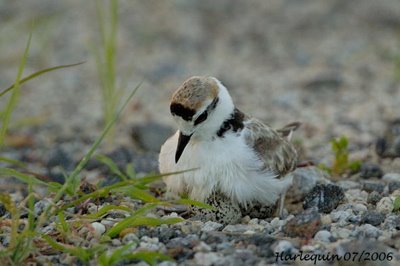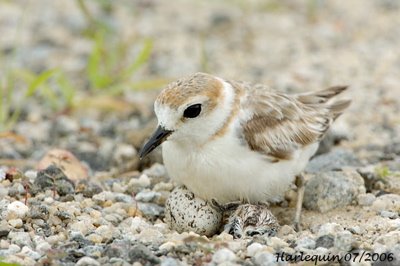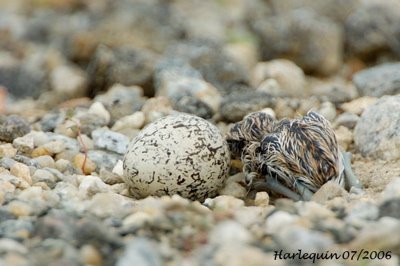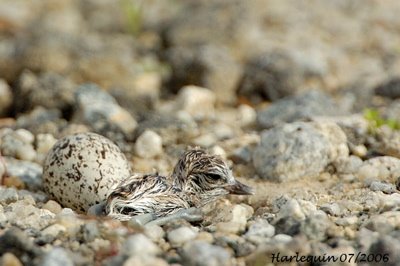Malaysian Plover 2: Nesting
Philip Tang has been stalking the elusive Malaysian Plover (Charadrius peronii) for the second year now. His mission is to record the nesting behaviour of this beautiful tiny bird. Originally designated locally as a rare resident, the bird is now considered by our bird specialist R. Subaraj, as an uncommon resident, but vulnerable, because of the transient nature of its habitat. That it is not so rare has been confirmed by Philip who managed to locate a breeding pair during each of his two years of study.
 [The image above shows the male bird in the nest incubating the two eggs while that below shows the bird with the two eggs in the nest]
[The image above shows the male bird in the nest incubating the two eggs while that below shows the bird with the two eggs in the nest] According to Philip: “The Malaysian Plover is found on sandy beaches, usually in remote areas with little human activity. They feed close to the water's edge, usually in pairs. The nest is just a simple depression on the ground, which is usually further up from the beach area. The two nests from both 2005 & 2006 were found in the oddest area, by the dirt road. The nest is usually very well hidden, away from views of predators. By using a vehicle as a hide and with lots of patience, I was able to spot (with lots of luck) the pair roosting and feeding near their nest. Spotting a nest with eggs or chicks among the grass and sand can really put a strain on your eyes.
According to Philip: “The Malaysian Plover is found on sandy beaches, usually in remote areas with little human activity. They feed close to the water's edge, usually in pairs. The nest is just a simple depression on the ground, which is usually further up from the beach area. The two nests from both 2005 & 2006 were found in the oddest area, by the dirt road. The nest is usually very well hidden, away from views of predators. By using a vehicle as a hide and with lots of patience, I was able to spot (with lots of luck) the pair roosting and feeding near their nest. Spotting a nest with eggs or chicks among the grass and sand can really put a strain on your eyes.  [Above image shows the female bird with the first-hatched chick and the unhatched egg; the two below, without the parent bird]
[Above image shows the female bird with the first-hatched chick and the unhatched egg; the two below, without the parent bird]
 “These birds nest on sandy grounds very close to vehicle tracks within the area. There are lots of wild dogs and raptors around. Human activities are plentiful with the ramp up of construction there. For my first sighting, I once almost stepped onto a nest with two eggs, so perfect was the camouflage. From then on, I walked with utmost care. Similarly, eggs and newborn chicks blend in very well with the surroundings.
“These birds nest on sandy grounds very close to vehicle tracks within the area. There are lots of wild dogs and raptors around. Human activities are plentiful with the ramp up of construction there. For my first sighting, I once almost stepped onto a nest with two eggs, so perfect was the camouflage. From then on, I walked with utmost care. Similarly, eggs and newborn chicks blend in very well with the surroundings.  [Above, nest with two eggs, note that the the chick is pecking out from the egg on the right. Below, male bird with chick under her wing]
[Above, nest with two eggs, note that the the chick is pecking out from the egg on the right. Below, male bird with chick under her wing] “It takes me quite a while to be able to spot them each time I return to the area.
“It takes me quite a while to be able to spot them each time I return to the area.“The parents (especially the female) will always move around the nesting area, bringing the chick(s) along, by calling out for them. When the parents sense any danger/threat, they will show the broken wing routine to distract the predator away, and the chick will receive a signal to lie low and stay very still without moving, until the parents call out for them when there is no more danger. I have spent many times looking for them once I lost focus when they moved into the grass area.
“One of the parents will also fly around and away from the nesting/chick so as to lure the predator away as far as possible.”
Input and images by Philip Tang. Part 1 on the birds can be viewed here.
Labels: Nesting



0 Comments:
Post a Comment
<< Home